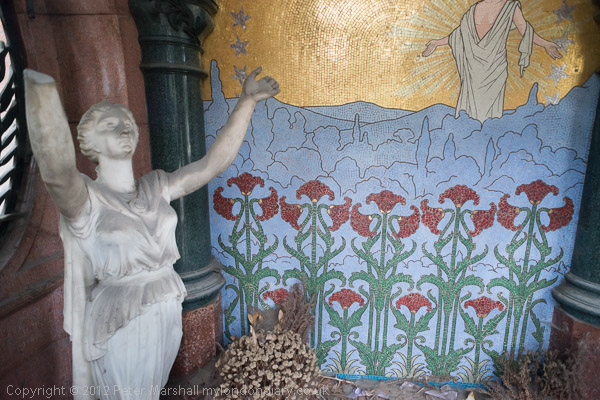
Although Sunday had felt rather like the end, and my gut had put an end to all my plans, we still had most of Monday to fill before it was time to go the the Gare du Nord for the late afternoon train home.
My plans had been to go out for a good meal at one of our favourite cheapish restuarants in the 5e on Sunday night, with a few glasses of wine, then on Monday to book out of our hotel, leaving our cases to collect later, have a leisurely meander around a few of our favourite places, perhaps morning coffee in a cafe, then a little more wandering before a long and satisfying lunch, getting up from the table in time to collect our bags and walk to the station. But in my state I spent our last 24 hours in Paris eating nothing and drinking the odd sip of water – I just couldn’t stomach the thought of anything more.
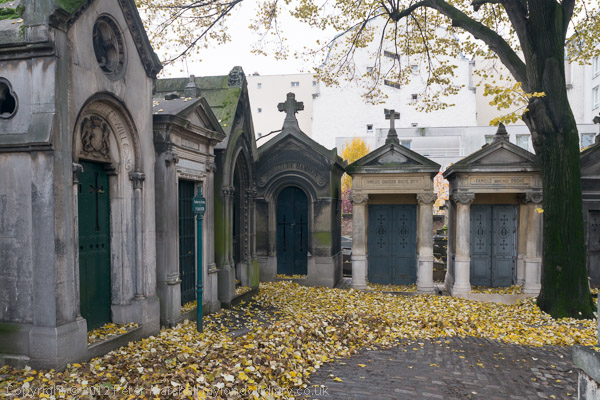
But we needed to do something to keep myself and Linda occupied, and we started with a trip to the cemetery. Montmartre cemetery isn’t really a gloomy place, though it’s pretty huge, and gives considerable employment to the gardeners who were busily blowing the leaves from one place to another. We’d actually hoped to be able to walk through it and out a gate at the north-east, but on reading the notices found that this is only open on one day a year – All Saints.
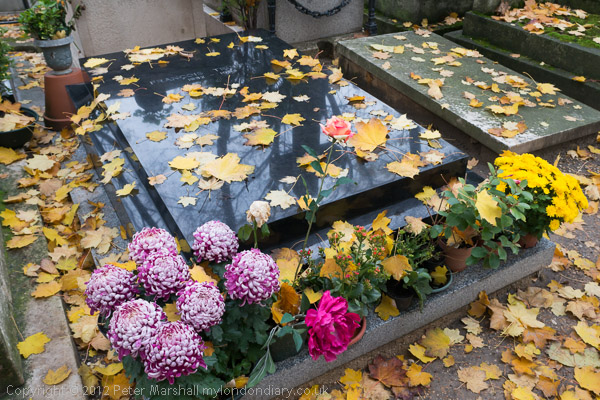
Truffaut’s grave was a simple polished black slab
So we just walked around a fairly small part of it, finding some of the graves of the famous who are buried there (even some I’d heard of) and generally enjoying the atmosphere. It must be about the best time of the year to visit, with falling leaves and colour on the trees.
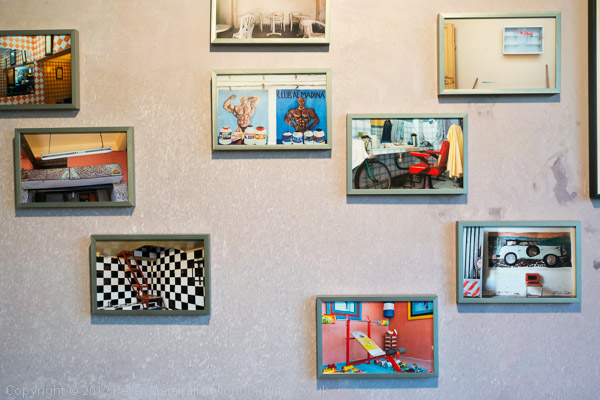
These small images at the side of the show were possibly of some of the rooms in Morocco
We then had to walk around the outside of the cemetery to revisit the Espace Central Dupon, which now held a different show, Mectoub by Scarlett Coten, portraits of young Maroccan men in their own surroundings. On her web site, she perhaps unhelpfully writes:
“« Mektoub », littéralement : c’est écrit”
– literally ‘it is written’, but it more means that whatever is referred to is predestined, already written in the book of life. And perhaps in photographing these men in their work place or home we see them in acceptance of their fate, their destiny and their offering it to the photographer for her images.
But perhaps what is more obvious is her sense of colour, and their ease at posing for the camera. You can see the series on her web site, and what is striking both on the wall and there is the huge amount of pinks and red, dominating almost all the images. It was certainly an interesting set of portraits.
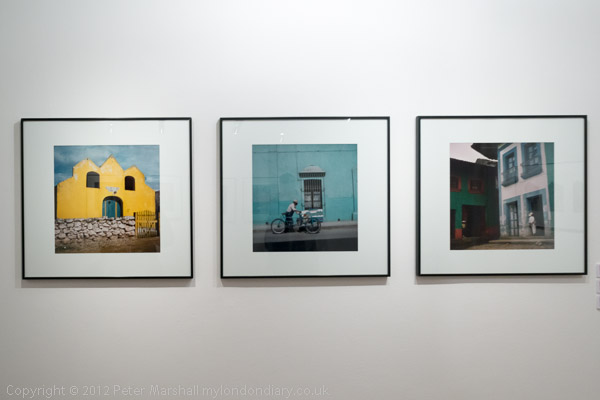
There were a few colour images in the Yampolsky show
From there we hurried across Paris to the 3e, where one of the few shows open on a Monday was the work of Mariana Yampolsky (1925-2002) at the Instituto Cultural de Mexico. Tepalcates continues there until the 29 March 2013.
Yampolsky was born in Chicago but grew up on her grandfather’s farm in rural Illinois. Her father was a sculptor and painter of Russian Jewish extraction, and her mother came from a wealthy German Jewish family. A year after she graduated from the University of Chicago in social sciences she went to Mexico City to study painting and sculpture and fell in love with the country, making it her home and becoming a Mexican citizen in 1958. In 1948 she studied photography with Lola Alvarez Bravo and Manuel Alvarez Bravo, and the more interesting work in this show clearly showed his influence on her work.
The name of the show, Tepalcates, is apparently the Spanish version of a Nahuatl word meaning a fragment or scrap of rough clay, and is used to refer to anything made from clay, particularly dishes and bowls. Perhaps the clay here is the ancient culture of Mexico which Yampolsky recorded and also the clay that was important in the vernacular architecture prominent in the work.
For me there was far too much work in the show – and too little time to look at it all before the show closed for the lunch hour. There were some images that caught my attention, and rather too many that seemed to be little more than a record, perhaps something unusual or even typical and doubtless of interest to some but perhaps not to a general audience. But perhaps I’m not the right audience, not in love with Mexican culture. I think of the little curiosities that so attracted Edward Weston when he spent time in that country – and which for me seemed simply wasted film and wasted time when he could have been producing more of the great images he made there.
Yampolsky’s work I already knew – for example on Zone Zero and here and here – had perhaps led me to expect something more interesting. The gallery was closing for lunch, and it was time to leave before I had a really good look. But perhaps if I get back to Paris before March 29 I might go back and have another look.
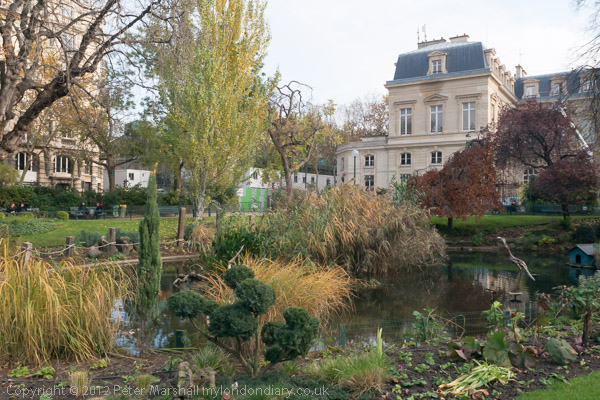
The gardens in the Square du Temple
Not that I wanted lunch. I went with Linda to a brasserie, but couldn’t face the smell or sight of food, and went to sit and read in the winter sunshine in the Square du Temple while she ate.
We did some more wandering in the afternoon, mainly by accident, and came upon the show Barcelone Annees 60, photographs by Narcis Darder Bosch (1923-2006) and Ricard Duran Bargallo (1916-1986) The PDF catalogue here has more pictures. Bosch was a succesful industrialist and a keen amatuer photographer, while Bargallo who started with an interest in cinema and painting and worked in the textile industry made photography his means of expression. While much of the work on show was very much in the amateur photography tradition, some of Bargallo’s work seemed more interesting.
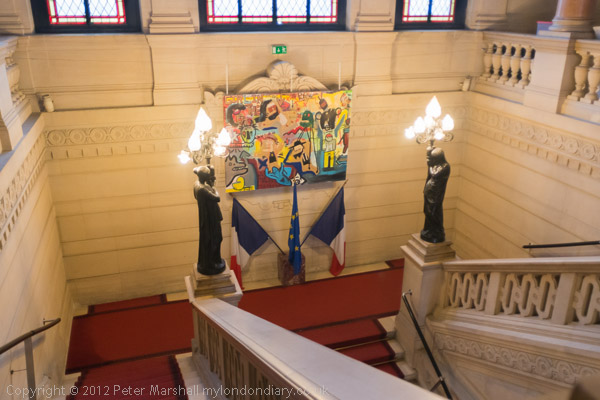
The staircase in the Mairie
Finally back at the Square du Temple we went inside the Mairie of the 3e, where another exhibition had opened that morning, Paris Couleurs 1960 by Jean Jéhan. A young man from the country, when he had to do his national military service he was stationed in Paris, and decided that after that he wanted to be a photographer. So he bought a camera and spent most of his off-duty time travelling around Paris and taking photographs on 120 film of the people he met on the street and anything that interested him. 200 of these colour images have now been published in a book, Paris-Bohème 1960, with a preface by Charles Aznavour.
From the large selection on show at the Mairie gave an interesting view of the city, which has changed considerably since then. He was photographing more or less at the time when I first came to the city, although I didn’t photograph it at all seriously until 1973. You can get a flavour of the work from the poster and a brief article on the show.
It was time to make our way to collect our suitcases and go to the station. On the way we bought some quiches, in case either of us felt hungry on the way home. I hadn’t eaten for over 24 hours, and it wasn’t until I got back home around 8pm that I felt at all like food – and the quiche was delicious.
All your London photos on this site are filled with people, and nearly all your Paris photos are devoid of them.
Not quite all. But you are basically correct.
In London I produce two kinds of pictures, covering protests and other street events and also urban landscape. Recently we’ve had a lot to protest about and that work has dominated my time. It’s also the work that I sell through Demotix and other agencies.
I was in Paris basically to look at photography rather than take pictures, and deliberately didn’t get involved with photographing any protests (I’ve done a few there in the past.) But most of the projects I’ve done in Paris haven’t been about people – as you can see at http://peter-marshall.com/ or in the two Blurb books I’ve done on Paris
http://www.blurb.co.uk/bookstore/detail/3641990#author-bookshelf